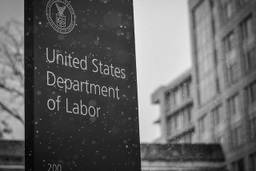
The “wellbeing of America and the American worker is my North Star,” President Donald Trump trumpeted at a recent White House event.
But the Trump administration’s policies are already adversely affecting workers’ health by undermining occupational illness prevention — including for cancers, musculoskeletal disorders and respiratory diseases that afflict hundreds of thousands of U.S. workers.
“It couldn’t get much worse in terms of the federal government’s role in preventing the number of occupational illnesses and diseases,” said Charlotte Brody, vice president of health initiatives at BlueGreen Alliance, an alliance of labor unions and environmental organizations.
Or, as Sidney Shapiro, a professor at Wake Forest’s law school, put it, “We weren’t doing this terribly well under a reasonably friendly administration so all bets are it’s now going to fall completely apart.”
Deaths from occupational diseases
Occupational fatalities remain a grave problem in the United States. In 2015, 4,836 people died on the job. Yet the National Institute of Occupational Safety and Health (NIOSH) estimates that approximately ten times more Americans die per year from occupational diseases. Of the 2,905,900 non-fatal workplace injuries and illnesses the Bureau of Labor Statistics (BLS) catalogued in 2015, about 187,900 were job-related illnesses.
This number, like all official records of occupational illness, is considered a significant undercount. Among other omissions, including very small workplaces and self-employed workers, these numbers don’t include work-related illnesses diagnosed after someone left a job or fully account for chronic conditions.
“Combine that with people who are immigrant workers with limited English, who are not organized, and low-income, who are vulnerable to exploitation because they’ll do anything to get a job — and they’re less likely to object to unsafe working conditions, less likely to seek help or speak up,” says Michael Wilson, director of the occupational and environmental health program at BlueGreen Alliance.
The most frequently reported U.S. work-related health problems include respiratory and skin diseases along with musculoskeletal disorders. Musculoskeletal problems account for about one-third of all reported workplace illnesses and injuries and affect workers in industries ranging from meatpacking to nursing, shipyards, cleaning services, manufacturing and retail grocery stores.
Cancer is one of the hardest occupational diseases to account for given the typically long time between exposure and diagnosis. But the most recent Centers for Disease Control and Prevention (CDC) estimate is that past exposure in the workplace caused between 45,872 and 91,745 new cancer cases. That estimate, which the CDC said is likely an underestimate, was for a single year.
Delays cost lives
Connecting workplace exposure and disease diagnosis precisely can be complicated. But the links between occupational exposure to silica and beryllium dust and lung disease are well documented. Cases of these occupational diseases may well increase under Trump.
This month, OSHA delayed by three months the date on which its new silica exposure safety standard for the construction industry will take effect. This is the first update of the standard in more than 40 years and will reduce by half the silica dust level to which most workers can be exposed and prevent about 900 new silicosis cases each year.
OSHA says the delay will allow it to “conduct additional outreach and provide educational materials and guidance for employers.” But the rule “has been decades in the making” and “will save more 600 lives each year,” according to Jessica Martinez, co-executive director of the National Council for Occupational Safety and Health.
Major industry trade associations, including in construction, oil and gas extraction, have long opposed the new standard.
Meanwhile, the Department of Labor (DOL) has twice postponed implementation of its rule updating standards for workers’ protection from carcinogenic beryllium dust. Like silica, exposure to beryllium, used in construction, shipyards, foundries and industries that use the metal to make electronics, aerospace, defense and other components, causes incurable lung disease and lung cancer.
“OSHA estimates that when fully implemented it [the rule] will save 94 lives a year. Every four days of delay in the implementation dates costs the life of one American worker,” wrote Michael Wright, director of health, safety and environment at United Steelworkers, in comments submitted to the DOL.
Republicans want the regulation delayed indefinitely and are calling it a “midnight” rule, implying the Obama administration rushed it through. In fact, the rule results from a process that began in 2002.
Also delayed are Environmental Protection Agency rules to prevent emissions of formaldehyde, a carcinogen and serious respiratory hazard, from manufactured wood products, to increase safety at industrial plants that use and store highly hazardous chemicals and to increase protections for pesticide applicators.
Tracking occupational illness
Trump has now signed two bills that will make it harder to track occupational illness. One undoes a rule requiring federal contractors to fully report all labor law violations. The other undoes a rule to strengthen employers’ workplace illness and injury recordkeeping requirements. Both were nullified with Congressional Review Act (CRA) resolutions that prevent an agency from ever issuing a comparable regulation. At an April 5 briefing for reporters, White House director of legislative affairs Marc Short called passage of these bills “a huge accomplishment.”
“Recordkeeping is so important because it allows OSHA to research what’s really putting workers at risk and to target the most serious hazards affecting workers,” says Emily Gardner, Public Citizen worker health and safety advocate.
And, says Wilson, “Who’s bearing the disproportionate burden of exposure to substances like silica and asbestos gets submerged if we don’t know it’s happening.” Without this evidence, managing the problem becomes harder.
Trump budget threatens safety training and enforcement
The White House “budget blueprint” proposes eliminating OSHA’s Susan B. Harwood training grants. “The Harwood grants include very important training programs to reduce occupational illnesses, like grants that go out to train workers in nail salons and beauty parlors,” on exposure to hazardous chemicals, explained David Michaels, George Washington University professor of environmental and occupational health and Obama administration Assistant Secretary of Labor for OSHA.
These grants, which cost the federal government about $11 million annually, are probably the biggest source of worker “training about rights and procedures” on “preventing and reporting occupational illness,” said Craig Slatin, University of Massachusetts Lowell professor of health education and policy.
Proposed DOL funding cuts will also likely reduce OSHA’s already constrained enforcement budget. “OSHA is primarily an enforcement agency,” said Center for Progressive Reform executive director Matthew Shudtz. OSHA’s budget determines what the agency “can do to fight occupational illness,” he explained.
For example, OSHA funding will help determine what the agency can do to update its limited and outdated chemical safety standards, said Shudtz. These resources will also influence how OSHA uses what’s called the general duty clause. This sounds obscure but it’s key tool for the agency’s enforcement of workplace health and safety. It allows OSHA to enforce a general standard of safety “even when rules are outdated,” Shudtz explained. “This is really important in the illness context,” he said, particularly where specific safety standards are outdated or non-existent. The Obama administration pursued such cases but it seems unlikely that the Trump administration will do likewise.
So far, the Trump administration’s decisions impacting occupational health “are profoundly political, not scientific,” said Brody.
“How someone gets sick is always complicated,” she said. “And as long as there’s doubt and industry can pay for that doubt to be generated, we don’t move ahead on protecting workers.”







